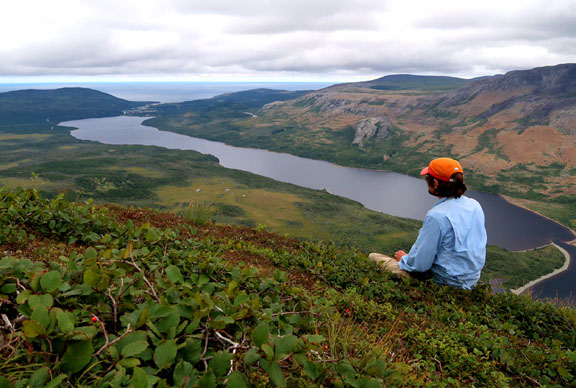January 2013 marks the introduction of two new website series on the Natural and Cultural Heritage found along the International Appalachian Trail, from eastern North America to Western Europe. The IAT Natural Heritage series will showcase concise illustrated stories on both nature and geology, while the IAT Cultural Heritage series will include stories on e.g. human history, art, and architecture.
This first piece on IAT Natural Heritage by Beyond Ktaadn’s Mike Jones (IAT North America Alpine Ecologist), Liz Willey, and Marilyn Anions was excerpted and adapted from their new Eastern Alpine Guide, and is titled:
Common Alpine Plant Species along the IAT in North America
From a botanical perspective, one of the more striking differences between the Appalachian Trail (in the strict sense, from Georgia to Maine) and the International Appalachian Trail (the corridor from Katahdin to the Great Northern Peninsula of Newfoundland) is the diversity and extent of alpine tundra ecosystems found along the latter (Figure 1).

Figure 1. Extensive alpine and subalpine plant communities occur along the length of the IAT in Maine, Québec, and Newfoundland. (Mont Logan, Québec)
While the AT traverses notable tundra areas on Mount Moosilauke, Franconia Ridge, and the Presidential Range in New Hampshire, and Katahdin in Maine, the IAT not only traverses Katahdin, but also cuts across tundra communities along the Mont Chic-Chocs and Mont Albert and Mont Jacques-Cartier and the Monts McGerrigles in Québec, and Table Mountain, the Lewis Hills, Blow Me Down, the North Arm Hills, the Long Range Mountains, among several other Newfoundland mountains, before reaching the North Atlantic at the Strait of Belle Isle. These “tundra” ecosystems share many plants with the true tundra of the far north but are subjected to very different environmental stressors. In most cases, eastern alpine tundra occurs above or near the limit of natural tree growth (Figure 2).

Figure 2. Eastern alpine tundra occurs above, and in association with, the limit of natural tree growth. (Mont Jacques-Cartier, Québec)
Atop these higher summits, isolated subarctic vegetation is perhaps the most visible and unifying characteristic of the eastern North American alpine areas. For many subarctic plant species, the highest mountains of New England, Québec, and Newfoundland and Labrador represent fragile outliers near the southern periphery of an enormous range. For some of these plants, their main territory often extends across expansive treeless areas of subarctic Canada (and in many prominent cases, such as moss campion [Silene acaulis] and sibbaldia [Sibbaldia procumbens], Europe and Asia). Arctic-alpine vegetation classically exhibits brilliant flowers amongst low, tangled mats and cushions whether you’re in the Cascades, the Sierra, the Rockies, or (of course) the Alps, and this is certainly the case in eastern North America (Figure 3).

Figure 3a-b. Tangled mats and compact cushions are common growth forms of arctic-alpine plants. (Left, entire-leaved mountain avens (Dryas integrifolia); right, moss campion (Silene acaulis))
Bedrock composition is an important factor in determining local plant distributions  around the world, but the influence of bedrock may be amplified in alpine areas where trees are rare and are thus less of a factor in the abiotic environment of the understory. There is little to shield the wind or keep soil or moisture in place, making bedrock composition a particularly important factor. Most of the eastern alpine mountains are composed of igneous or metamorphic rock such as granite, gneiss, gabbro, anorthosite, and other rocks, with relatively few composed of calcium-rich rock such as limestone. These common rock types support and encompass the major functional groups of alpine plant communities, essentially comprising a graded suite of “typical,” or common, alpine plant communities throughout much of the region. However, two major rock types (serpentine and limestone) may dramatically influence the overlying vegetation. Each of these support plant species and plant communitites different from those found on granite (Figure 4).
around the world, but the influence of bedrock may be amplified in alpine areas where trees are rare and are thus less of a factor in the abiotic environment of the understory. There is little to shield the wind or keep soil or moisture in place, making bedrock composition a particularly important factor. Most of the eastern alpine mountains are composed of igneous or metamorphic rock such as granite, gneiss, gabbro, anorthosite, and other rocks, with relatively few composed of calcium-rich rock such as limestone. These common rock types support and encompass the major functional groups of alpine plant communities, essentially comprising a graded suite of “typical,” or common, alpine plant communities throughout much of the region. However, two major rock types (serpentine and limestone) may dramatically influence the overlying vegetation. Each of these support plant species and plant communitites different from those found on granite (Figure 4).
Figure 4. Common alpine plant species may vary depending on slope, aspect, elevation, and bedrock composition. Metal-rich serpentine, derived from the earth’s mantle, supports plant communities distinctive from those found on granite, gabbro, or gneiss. (Lewis Hills, Newfoundland)
On granite, though, and gabbro, gneiss, schist, quartzite, and other rocks, a widespread suite of alpine plant species appears. These species occur on most or all of the major alpine areas along the IAT in North America. This particular suite of plants has been profiled in two excellent books published by the Appalachian Mountain Club: Nancy Slack and Allison Bell’s AMC Field Guide to New England Alpine Summits and Dr. Stuart K. “Slim” Harris (and colleagues)’ Mountain Flowers of New England. The most common plant communities span the major classes of rock, including igneous (e.g., basalt, granite) and sedimentary (e.g., sandstone) rocks and their metamorphic (e.g., schist and gneiss) derivatives. Most of the major and familiar alpine mountains throughout the eastern region and along the IAT fit into this broad category, including the the Northern Long Range Mountains (gneiss and granite), Katahdin and Mont Jacques-Cartier (granite), and the cap of Gros Morne (quartzite) (Figure 5).

Figure 5. The “cap” of Gros Morne in Newfoundland is composed of quartzite (foreground), which stands out in contrast to older surrounding rocks of the Rocky Harbour Hills and Long Range Mountains.
This widespread eastern alpine vegetation is often dominated by plants in the heath family (Ericaceae). Prominent among these are many species of cranberry, bilberry, and blueberry (Vaccinium spp.), Lapland rosebay (Rhododendron lapponicum), alpine azalea (Loiseleuria procumbens), and alpine bearberry (Arctostaphylos alpina) (Figure 6a–e).

Figure 6a-e. Common alpine plants in the heath family (Ericaceae) include alpine bilberry, mountain cranberry, Lapland rosebay, and alpine azalea.
Diapensia (Diapensia lapponica) and crowberry (Empetrum spp.) are also common constituents, and are closely related to the heaths (Figure 7).

Figure 7a-c. Other common alpine plants include diapensia and black crowberry. In western Newfoundland, pink or Eames’ crowberry may be locally common on alpine summits.
These species are often encountered together on windswept alpine ridges, in frequent association with numerous grasses, sedges, bulrushes, and rushes. The dominant sedge is usually Bigelow’s sedge (Carex bigelowii). Tufted clubrush (Trichophorum caespitosum) and highland rush (Juncus trifidus) are also common plants in this ecosystem (Figure 8). Both are tuft-forming species tolerant of a variety of alpine conditions. Over large areas of many eastern mountain ranges, including many areas along the IAT, various combinations of these plant species become the most abundant.

Figure 8. Among the more common graminoids found in eastern alpine habitats are Bigelow’s sedge, tufted clubrush, and highland or three-forked rush.
Well-protected snowbed or seepage areas such as alpine springs and streams and the damp headwalls of glacial cirques, support different vegetation than the exposed ridgelines and summits. Tuckamore or krummholz (dwarfed forests near treeline) support plants typical of boreal ecosystems below treeline. Expansive areas of talus, and adjacent cliff-faces, also support distinctive species. These and other plant communities are discussed in greater depth in upcoming installments, and in the Eastern Alpine Guide (http://easternalpine.org).



